Tais 28 August 2014: What is Your Dream?
The school is supposed to start at eight in the morning, and to finish at twelve. But none in this Papua New Guinean coastal village have clocks. Including Madam Singai, the only school teacher in the village. Nevertheless, she knows perfectly when she should start her class. That is when she has finished the cassava cooking and baby feeding in her house, and when she believes the sun is high enough. She then roams around the village, shouting all her students’ names. Dozens of barefooted students then resemble a parade of obedient ducks, follow her to the school hut at the end of the village. Madam Singai also knows when to finish her school. That is when most of her students make so much of noise, crying because of being hungry, or because of her own stomach produces noise calling for lunch.
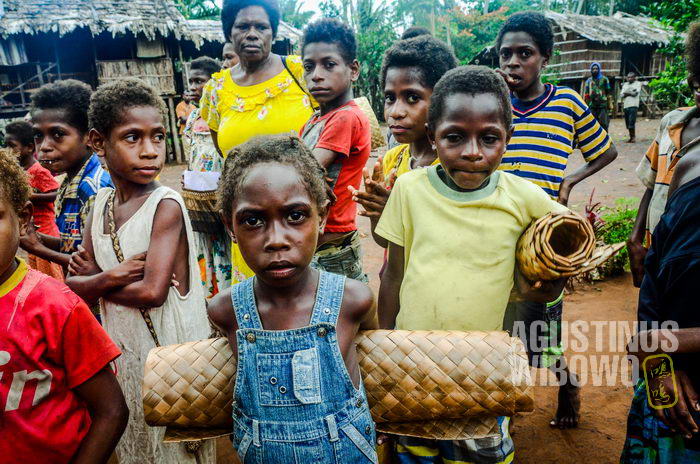
After gathering the students, Madam Singai is ready for the class today.
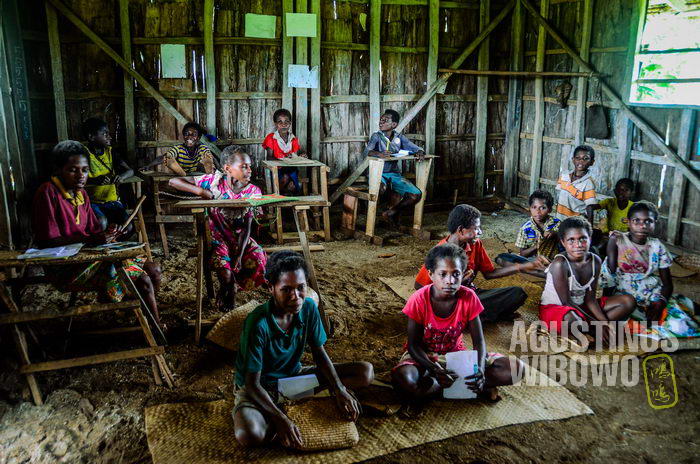
The classroom for the Grade I and II students.
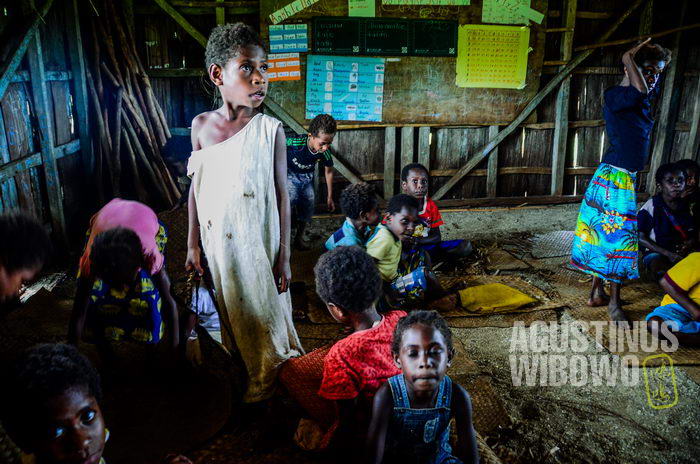
Centipedes disrupted the class.
Of course once in a while Madam Singai thinks how much better life would be if she could split herself into two. She alone has to take the responsibility of all of the fifty two students in this village. The school building, which is a wooden hut with bark walls and seems may collapse at any time, is split into two classrooms. One room is for the Prep students, and the other is for Grade I and II students. When Madam Singai teaches the little pupils sitting on leaf mats on sandy ground to spell A-B-C-D, the older students in the opposite classroom jump around and run outside merrily. When Madam Singai goes back to the opposite classroom—which has six tables and limping chairs, to calm down the Grade I and II students, now it’s the turn for the Prep students to cry loudly because of poisonous centipedes making appearance on the ground they are sitting on.
That day, Madam Singai invited me to the class. She cramped the students of both classrooms into one; all the students sat on the ground. She introduced me to them as markai—a white man—coming from the neighboring country named Indonesia. Indonesian border is merely 150 kilometers from here, but it seems a world away. Many of the students shrunk, shivered when seeing me for the first time. My fairer skin has brought a horror to them. In their belief, white is the skin of the dead souls. The other reasons they were more frightened, was because I came with something that they rarely got: questions.
“Please tell me, what are your dreams?”
Madam Singai translated my English question into their local language. None of those children answered.
“What do you want to be when you get older?” I asked again.
Again, nobody answered. I had to repeat my questions again and again, and gave them example of my own dreams when I was a young kid like them. But still, my questions were just like throwing stones to the bottom of a lake.
“They don’t have dreams,” finally said Madam Singai to me. She is the only one in this room who was not barefooted as she was wearing a pair of tattered flip-flops. “In our education system, the students were already failed by their parents.” The parents, she said, never had any dreams, and they never understood the importance of formal education for their children. Madam Singai then represented her students to answer my question. “We want to go to Indonesia, we want to see Merauke. We want to learn the Malay language.” Tais is a tiny coastal village in the isolated Western Province of Papua New Guinea, while Merauke is the easternmost town of Indonesia, the closest Indonesian town from Tais, a two-day boat journey away.
She then face her students, talking only in the local Na language—of which content later Madam Singai translated to me. She said that Indonesia was a big and modern country which could produce anything they could imagine: clothes, trucks, food, airplanes. If you notice, most of the clothings the people in this village wear were made in Indonesia; some even wore T-shirts with design of Indonesian political party or political leaders (distributed freely in during elections), some wore Indonesian army shirts, some children wore shirts depicting Indonesian movies.
“But our country,” continued Madam Singai, “could not make anything because we don’t study hard, we don’t work hard, we don’t have dreams.”
After Madam Singai finished her long speech, then one by one the older students (of Grade II but some are big enough to be considered high school students in Indonesia) raised their hands and said their dreams: to be a pilot, to be a driver, to be a doctor, to be a journalist like me to see the world.

“What are your dreams?”
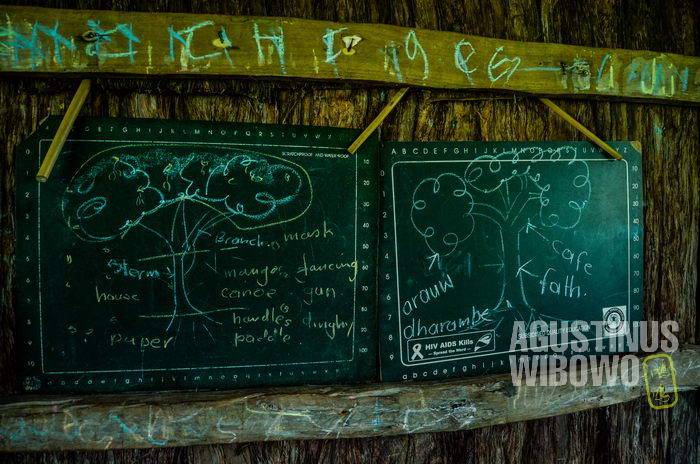
As they don’t have text books, Madam Singai has to draw on the board every time she teaches.

The class finishes when everybody is hungry.
Madam Singai herself never visited Merauke. She only heard about Merauke from her husband, who had been there several times. Later after the class, I sat under Madam Singai’s post house, listening story of her husband, Singai Suku the village “chairman”—about their dreamland: Merauke.
“If you go to Merauke, you will see a good place, very very good place,” he said, “Not only cars and big buildings, but people over there, all of them, busy of working, producing something. In Merauke, women from Java go to rice field every morning until noon, then they take lunch, then work again until sunset. Here you will never see people as hardworking as that.”
I, an Indonesian, had never been to Merauke; and for the Singais this fact was ridiculous. For me and most of Indonesians, Merauke is a name very familiar, a border town which is always mentioned in our nationalistic slogans, but the real picture of the town itself is unknown. Honestly, Merauke was never more than a blank picture in my imagination, an isolated place, maybe a bigger town, but nothing special about the town itself. Contrary, listening to the description of this Papua New Guinean fellow about Merauke was like listening to a skilled storyteller telling the tale of faraway Shangri-La paradise.
“I have seen Merauke and I understand everything about Merauke,” said Singai, the fattest and the only fat man in this village and the one who always only wear a flip-flop on his left feet as he had lost the right one years ago. Even though his tattered flip-flops were only a half pair, Singai Suku always wore it proudly as it showed his higher status as a chairman of a totally-barefooted village. He then drew a circle in my notebook. “This is Merauke city, the center, where located the big buildings,” he said. Then he drew a bigger circle circling the first one, “This is half-city area.” Then another bigger circle circling the last one. “And this is the village. See, how clever they make their city!”
Madam Singai looked in awe. “Next time you should bring me there!”
“Sure I will bring you there,” said her husband, “I will show you how clever the Merauke people are.” Last year, Singai Suku went to Merauke, and came home with a dendeng—dried meat mixed with sugar and spices through the frying process—made of deer meet. That time he said to his wife, “See, Mommy, what they have done to your deer, our deer. This is the same deer, but they can make it very delicious like this one.”
Deer business is another bizarre thing created by the bizarre Indonesian—PNG border. Deer became a new diet for the PNG citizens near the border only in last few decades. Deer is an Asian animal, originally did not exist in New Guinea (Papua) island of which fauna are of Australian type. Deer was brought to West Papua by the Dutch during the colonial era (that time, the west half of the island was known as “Dutch New Guinea”), and there was even big deer farming in Merauke. Then, came the Indonesian soldiers, who liked to hunt deer in the forests with their guns. Deer hunting was so rampant that later people reported a huge exodus of deer crossing the border to the east. Now, deer has already extinct in the Indonesian side of Papua, but abundant in Papua New Guinea. The Indonesian illegal traders nowadays take the deathly risk to cross the border to Papua New Guinea to buy deer horns (which they would export to Singapore as Chinese medicine material). Some PNG villagers, especially those who live very close from the border, frequently go to Indonesia to sell deer meat.
The first time deer crossed the border, the Papua New Guineans of these border villages were scared of this mysterious animal. But then they learned how to hunt deer and eat the meet. They preserve deer in the only two ways of cooking they know: by boiling it, or by putting it directly into fire.
Remembering the delicious deer dendeng she ate last year, Madam Singai shook her head sympathetically. “I feel sorry for this white man,”—she means me—“In his country, he must eat very good food every day. Here, he has to eat the same food like us, the same food every day: boil cassava, boil banana, boil yam. Other than boiling and burning, how else we cook our food?”
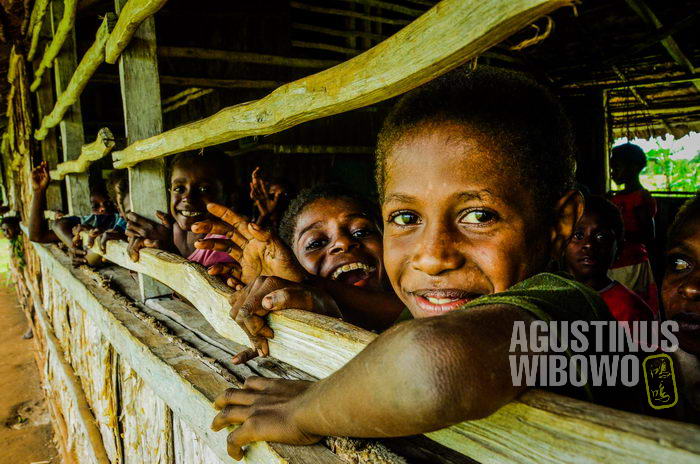
The happy students of Tais.

There are only two ways of cooking; boil it or put it in fire.


Leave a comment